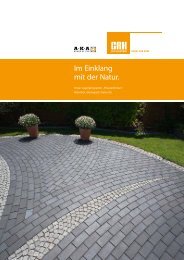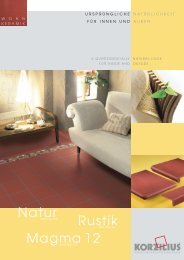Create successful ePaper yourself
Turn your PDF publications into a flip-book with our unique Google optimized e-Paper software.
Características técnicas Technical information<br />
4<br />
– Extender el mortero, peinando con una llana dentada de 6 a 10 mm. en paños inferiores a 1 m2<br />
para evitar su secado.<br />
– Si se encola también la baldosa aumenta la adherencia más de un 30%.<br />
– Mover y presionar ligeramente las piezas para asentar toda la superficie.<br />
– Nivelar y eliminar el exceso de adhesivo dejando las juntas vacías y limpias.<br />
5<br />
6<br />
THE ADHESIVE:<br />
Only type C2 TE cement-based adhesives should be used, suitable for laying porcelain tiles with a very<br />
low water absorption rate. The adhesive should be prepared and applied as per the manufacturer’s<br />
instructions, following these stages:<br />
• Layout planning. Starting out with two perpendicular lines, plan the layout of the tiles, following<br />
these rules:<br />
– Mark out a reference grid, with a one-metre space between each line (fig. 1).<br />
– Leave a 6mm gap between the tiles (the tile joint).<br />
– First position the corner coping tiles to determine the overflow level, followed by the tiles along<br />
the top edge of the pool (figs. 2 and 3).<br />
– Next plan the layout along the inner edges where the different surface planes meet.<br />
First plan the layout of the tiles along the vertical edges, followed by the horizontal ones. (fig. 4)<br />
– The walls should be tiled from top to bottom, laying the cut tiles along the bottom. The lanes and<br />
grid will serve as a reference. Lastly, continue with the bottom of the pool (figs. 5 and 6).<br />
– Insert expansion joints every 4 metres, so that the maximum area covered by a continuous<br />
stretch of tiles is 16m2. These expansion joints should coincide with those of the basin.<br />
• Laying the tiles: Follow the manufacturer’s instructions regarding the preparation of the<br />
adhesive, its working time and application temperature.<br />
– Spread the mortar over an area of less than 1 m2 so that it does not dry before required. Then<br />
comb it with a 6 to 10mm notched trowel.<br />
– By also spreading it over the underside of the tile, the bonding strength will be increased by over<br />
30%.<br />
– Move the tile slightly and press it down to ensure full contact with the base.<br />
– Level the tiles and remove any surplus adhesive, leaving the tile joints empty and clean.<br />
192<br />
EL REJUNTADO:<br />
Existen materiales específicos para cada tipo de junta, debiendo atenderse las instrucciones del fabricante<br />
de cada producto.<br />
• Antes de rejuntar esperar 48 horas sin pisar el pavimento.<br />
• Ejecutar primero las juntas de colocación con pastas impermeables del tipo CG2. Las juntas<br />
epoxi permiten la limpieza con elementos más agresivos.<br />
• Aplicar el producto con llana de goma, rellenando diagonalmente.<br />
• Limpiar las juntas antes de que se endurezcan usando quitacementos. El tiempo de fraguado<br />
depende del fabricante.<br />
• Realizar por último las juntas de dilatación, rellenando con pastas elásticas impermeables tipo<br />
poliuretanos o polisulfuros.<br />
• Dejar secar el conjunto al menos 21 días antes de llenar la piscina.<br />
GROUTING:<br />
Specific materials can be found for the type of joint in question. Follow the manufacturer’s instructions<br />
in each case.<br />
• Wait for 48 hours before grouting the tiles. Do not tread on them during this time.<br />
• First grout the tile joints, using a CG2 type waterproof grout. Epoxy grouts can be cleaned with<br />
tougher cleaning products.<br />
• Use a rubber trowel to apply the grout, filling the joints diagonally.<br />
• Clean the joints before the grout hardens, using cement remover. The setting time will depend<br />
on the specific product.<br />
• Lastly, fill the expansion joints, using waterproof elastic polyurethane or polysulfide sealants.<br />
• Leave the whole pool to dry for at least 21 days before filling it.





